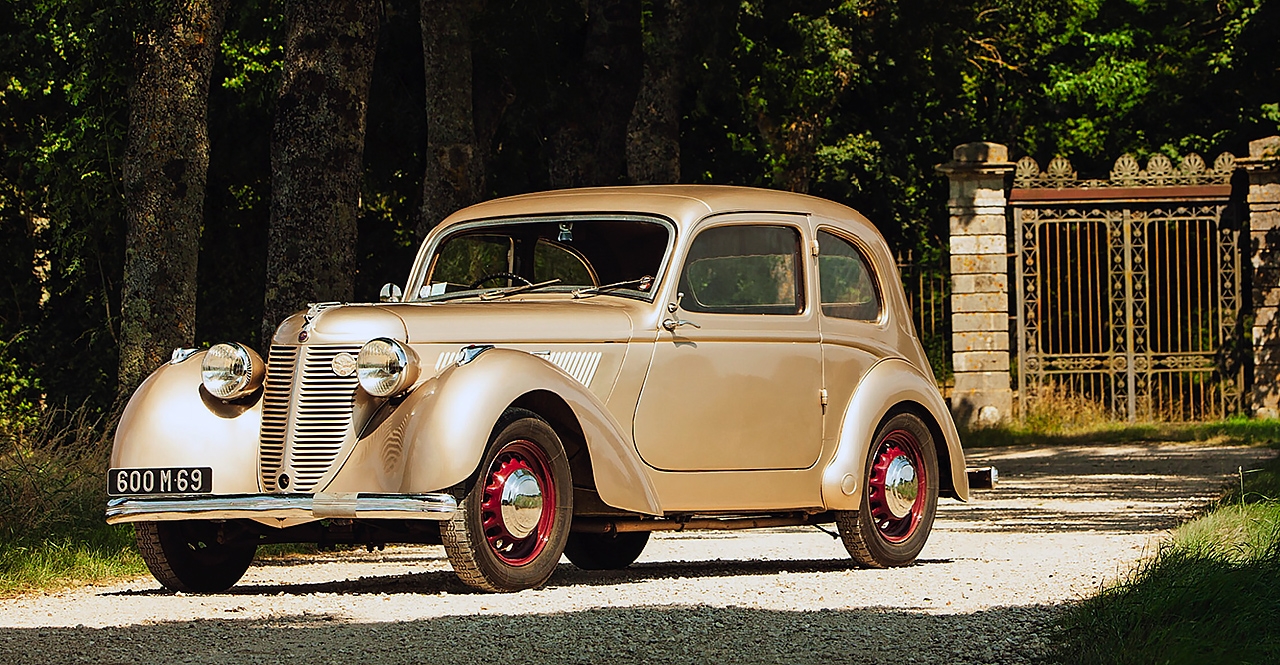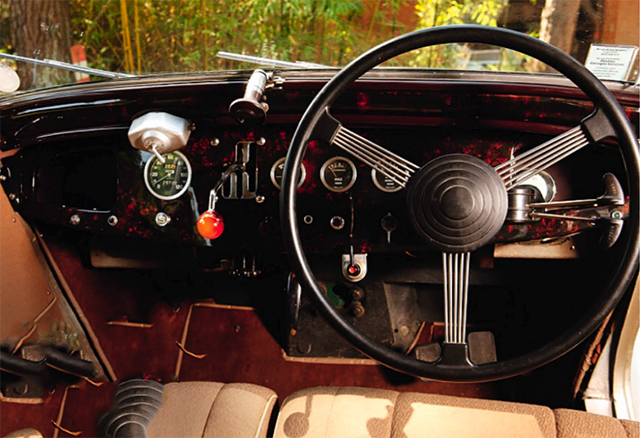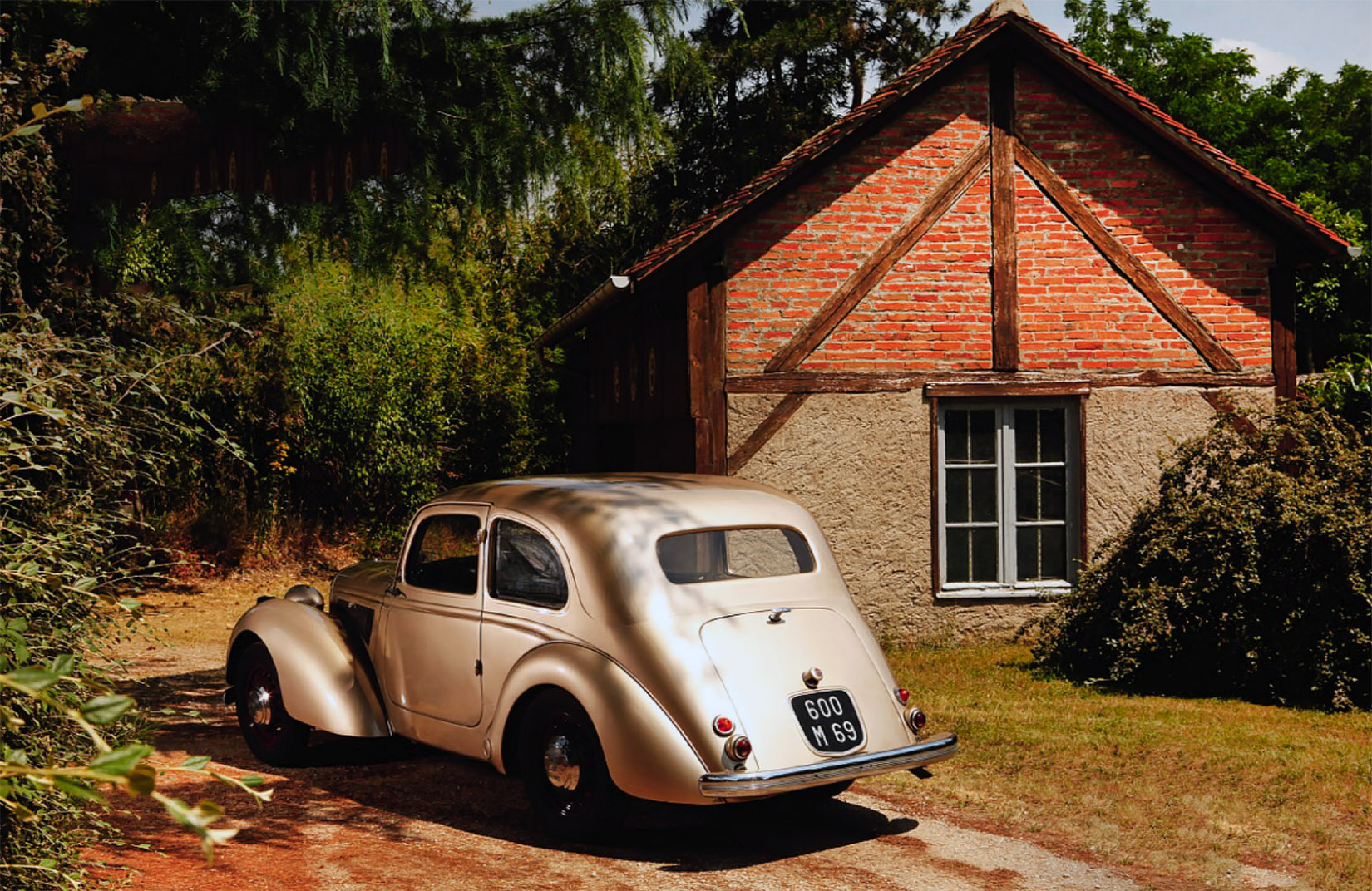
Compound Interest. Structurally avant-garde, the aluminium-hulled baby Amilcar promised so much. Jon Pressnell explains how a brave adventure turned sour. Photography Tony Baker.
Glinting in the early summer sun, taut-lined, low-slung, like a Hotchkiss in miniature, the Amilcar Compound looks so right. Could there be a classier late-’30s small French saloon? In its time, the Amilcar must have stood out like a beacon of discreet high-quality elegance among the shoals of Traction Avant Citroens, Peugeot 202s and Renault Juvaquatres on the roads of France. But the lithe little two-door – there was also a convertible-saloon and a roadster – in fact constituted a major miscalculation for its maker, and proved a disaster in both production and technical terms.
The story goes back to 1934, when the SIA, the equivalent of the UK’s Institute of Automotive Engineers, launched a competition to design a small popular car in tune with France s then straitened circumstances. Aluminium Frangais, the powerful national aluminium producer, weighed in with a further prize for the car making the best use of light alloys. This piqued the interest of Jean-Albert Gregoire, well-known as a pioneer of front-wheel drive with his limited-production Tractas. Gregoire conceived a structure based around Alpax aluminium castings, deeply ribbed internally and bolted together to form a rigid hull incorporating the cars scuttle.

Amilcar Compound B38 road test
At the end of 1935 Aluminium Frangais bankrolled Gregoire to build a prototype. Within a year a car had been made, by the simple expedient of dismembering a front-drive Adler Trumpf Junior and replacing its chassis and scuttle with alloy castings. The result, according to Gregoire, was improved rigidity, no increase in weight, and a structure that was in effect everlasting. The Adler was demonstrated to various manufacturers, but little interest was shown in adopting its untried and potentially expensive technology.
Brochures, some with Kow artwork, featured photos of alloy hull and captions extolling its virtues; simple in concept it was a disaster in practice.
The exception was Hotchkiss, a maker of quality motor cars in a niche below Delahaye and the like. Famed for its armaments, which had provided healthy profits, Hotchkiss was at a dangerous crossroads in 1936. The Popular Front government had nationalised its machine-gun operation, depriving it of a reliable cash-cow, and car sales were falling under the attack of mass-produced mid-sizers such as Peugeot’s 402.
A possible way forward was to build a high-grade small car, cheaper than the regular Hotchkisses and capable of being produced in greater numbers. In order to avoid potential damage to die company’s name, and at die same time to pick up on loyalty to another well-regarded manufacturer, Hotchkiss bought a controlling interest in SOFIA, the holding company that had owned Amilcar since 1934.

Best known for its sporting voiturettes of the 1920s, Amilcar was fading. Its bigger models were not attracting custom and a new small 5CV was failing to make a mark. It was the perfect platform for the Saint-Denis firm to launch a ‘mini-Hotchkiss’ and chief designer Vincenzo Bertarione and colleague Marcel Junion were duly tasked with creating a new 5CV model. The prototype, a conventionally engineered two- door saloon, was well under way when in Spring 1937 Hotchkiss boss Henry Mann Ainsworth inspected the Adler and commissioned Gregoire to come up with a new small Amilcar using front-wheel drive and his cast-alloy hull.
For a conservative firm this was an extraordinary decision – and all the more so, given that a perfectly acceptable in-house proposition was already well down the road. It has been suggested that the backing of Aluminium Frangais was a factor; also that Ainsworth perhaps judged that only a genuinely advanced new design would stand a chance of success, as a premium-priced alternative to more orthodox machinery. In fairness, too, with 40% of French cars and 70% of German cars being front-wheel drive, according to The Autocar, it was hardly outlandish that Hotchkiss follow this clear trend.

By the end of September, Gregoire had delivered a prototype, basically a remodelled Trumpf Junior, using Adler suspension and steering plus the sidevalve Amilcar 5CY engine.
The Bertarione/Junion project was uncere-moniously shunted aside and the Gregoire design shown at die 1937 Paris salon as die Amilcar Compound – so called because of its ‘compound’ body construction.
Features included twin transverse-leaf independent front suspension and independent rear suspension. This used two half-width torsion bars, set transversely in a tube that formed the front of a bolt-on steel rear platform, the tube nestling neatly into circular cut-outs at the end of the cast-alloy side members. There was rack-and-pinion steering plus a rear anti-roll bar. The gearbox was a cable-linkage four-speed unit, and the final drive sat between this and the clutch, in a separate alloy casing. Brakes were by cable, electrics were 6V, while the driveshafts used Hooke inner joints and Gregoire’s Tracta constant-velocity outers. The chassis longerons served double-duty as the sills, and the superstructure included wood door posts (slotting into sleeves cast into the side members), a wood- reinforced rear body, and wood-framed doors.
The car was now here near ready for production. The 929cc Amilcar engine was manifestly unsuited to the task of hauling along the hardly pocket-sized saloon, and the construction processes for the cast-alloy structure were untried.
A new power unit was hastily commissioned, modelled, at Ainsworth’s instigation, on the sidevalve Hillman Minx engine, and Gregoire was brought on board with one of his engineers to see the Amilcar through to commercialisation.
From top: diagram of alloy structure; cabriolet for UK; narrow cabin has typical French column controls, Jaeger instruments, with speedo on passenger side
Duly put on sale at the 1938 Paris show, where 500 orders were taken, the Compound limped into production, with just 38 sold in what remained of the year. In January 1939 the Amilcar was being built at the rate of three a week, a far cry from the projected output of 50 cars.
The truth was that Gregoire’s design was proving to be a production nightmare. Many of the castings had to be rejected because of flaws or because they were not to dimension, and much hand-fettling was required. Hotchkiss, meanwhile, simply could not devote the necessary engineering time to the project, because staff and financial resources were having to be diverted to armaments work in the internationally febrile period after the Munich Agreement.
Eventually the castings improved in quality and assembly processes started to be mastered, with monthly output climbing to 107 units in June 1939. In service, however, the supposedly everlasting alloy punt – initially guaranteed for two years – was soon suffering from failures, primarily in the front traverse, leading a prudent Hotchkiss to slash the warranty to six months. Meanwhile the gearbox, made by a sub-contractor, was developing a reputation for unreliability. Perhaps more to the point, the car’s construction was complex, featuring a mix of alloy castings, wood framing and steel pressings – including a roof made up of several elements welded together. This w as labour-intensive, while front-wheel drive added further to costs. With castings still having to be rejected as unfit, manufacture was running at a loss – or very close to it.
By then it was also apparent that the 1185cc sidevalve had been a mistake: developing just 33bhp, it gave the car a top speed barely above 60mph, making the Amilcar no more speedy than a much-cheaper Juvaquatre, and appreciably less lively than the zingy overhead-valve Simca Eight. With the car barely in production, Ainsworth therefore decided to equip the Compound with a bored-out pushrod version of the ‘Minx’ unit – the third engine to be used in the car since its inception. He was prepared to do this because he envisaged using the new 1340cc ‘four’ in the light military vehicles Hotchkiss was building with French firm Laffly.
Intended to have a three-speed gearbox with a rod-operated column change, the overhead-valve B67 Amilcar sported a more useful 42bhp. The Hotchkiss sales director, who continued to have a sturdy faith in die Compound, apparently regarded the revised car as having a bright future. But by the time that it received official homologation in August 1939, France was on the verge of war. It is thought that just five B67s were made. Compound production ceased in the course of 1940, but subsequently a series of 150 vans was produced during 1942 and 43, mainly for the postal services and the Red Cross in German-occupied France. Meanwhile, the B67 engine was made in substantial numbers for an Austrian manufacturer of fire pumps.
Whatever the talking-up of the Amilcar by Gregoire in his memoirs, the venture had not proved a happy one for Hotchkiss. Needlessly expensive to make, underpowered, cramped inside, and costing half as much again as a Fraction Avant, what had seemed like a good idea on paper had turned into a millstone around the company’s neck. Many buyers were known to be disappointed. Even while it was grappling with manufacture of the car, Hotchkiss had considered replacing it with a conventional rear-drive 11CV with the aluminium hull or with a more orthodox all-steel small car. It was thus no surprise that production did not re-start after the war. Just 872 Amilcar Compounds were made in all, against a planned first sanction of2 500 cars.
There are 70 recorded survivors, a reflection upon the resistance to rust of the largely aluminium structure. To find out whether owners today are having the last laugh, it was a welcome exercise to try the 1940 Compound of Jacques Paquereau, the only overhead-valve B67 known to exist. Originally belonging to the financial director of Hotchkiss, it was a wreck when acquired, with the roof chopped off to make a cabriolet and a rod through the block. Despite the plan to equip the B67 with a three-speed ’box, that on the Paquereau car is a four-speeder with the dashboard change of the sidevalve cars.
Styling is elegant, with perfect proportions; Art Deco Amilcar mascot is of Pegasus; open-gate gearchange, close to your knees, has amber knob.
IT’S AHEAD OF MANY A BRITISH SALOON OF THE TIME, BUT A TRACTION AVANT SHADES IT
In essence a reduced-scale Hotchkiss Modane two-door saloon, the body has a shapely fencer’s mask prow, a long bonnet, and a tightly drawn glasshouse. With domed-glass Marchal headlamps and proprietary Deco-like sidelights, the car lives up to its catalogue claim of offering ‘exceptional elegance for a small-capacity car’. The payoff is a notably compact cabin for a car that is a full 13ft 6in long. It’s easy to forget that a regular Oiize Legere Traction Avant is quite narrow across the shoulders. All the same, in the Amilcar the driver has the wheel on his thigh, the gearlever is right over on the passenger side – with a mechanism just by your knees – and you almost hit the knob for the ’screen on a change to third. Meanwhile, even small people in the rear will be rubbing their knees on the seatbacks.
That’s not to say that the interior of the Compound is a disagreeable place to be. Quietly tasteful trim in brown cloth with cream piping is in the French idiom of the time, and there is a decently stocked dashboard in high-gloss dummy wood, with matching door cappings. In the back there are small map pockets. The front floor is completely flat, with parts of the Alpax castings visible. There’s nothing flashy about it, but the presentation is one-up on the painted tin and coarse fabrics of cheaper French cars.
Despite die extra 9bhp of the pushrod engine, Paquereau says there’s not much improvement in die performance: 45mph is quite sufficient as a cruising speed. The soundtrack is appealingly crisp, and acceleration in the lower gears is respectable enough, with strong pick-up in third. Despite relatively high gearing, the Amilcar is nicely flexible in top; throttle back, and a 25mph dawdle in top is satisfactorily refined. But there’s none of the easy, broad-shouldered responses of the Citroen – a bigger-engined car, of course, but also one that was appreciably cheaper. “It’s not a car for doing any distance,” admits Paquereau, “but a 202 was no better at the time.”
As for the patented cable-operated dashboard gearchange, with its exposed chrome gate and lovely round amber knob, this is not a patch on that of the Traction Avant. Only third and top are synchronised – and careful double-declutching is necessary to avoid a clashing of gears – but the action is precise and the clutch well weighted.
Chassis behaviour is secure. The car holds a line well, aided by the accurate, if stiff, rack-and-pinion steering, and there are no shakes or rattles through the structure. With rotary-action Houdaille dampers front and rear, the car bucks around on poor roads and feels under-damped at the front. Relative to many a British small saloon of the time, it’s ahead of the game, but, again, a Traction Avant shades it.
More of a concern are the cable brakes. Soft at the pedal, they pull to one side and stop the car poorly. A bit of spannering might improve matters, but the fact that various survivors have been converted to hydraulics speaks for itself.
Had the Amilcar been favourably priced and profitable to make, none of its dynamic deficiencies – perhaps in this case exacerbated by the passage of years – need have militated against it. After all, contemporary Peugeots hardly excelled in their braking, and nobody has ever contended that a Juvaquatre was a paragon of virtue when it came to roadholding and handling. But the concept was fundamentally flawed. It was too ambitious a project for Hotchkiss, and could never have been sold at a price that would have made it an attractive proposition for more than a handful of well-heeled customers.
Today is has charm, rarity and technological interest on its side, and would make a perfect companion to a ’30s Hotchkiss – or even to a post-war Hotchkiss-Gregoire. Yet it is hard to pinpoint any particular virtue so salient that it would make it a better choice than more main-stream medium-sized French cars of the time. Arguably, that was the Compound’s fatal flaw when new. Advanced design has to be affordable, has to work, and has to offer clear advantages over more conventional practice. Sadly, the Amilcar foiled on all three counts.
Amilcar essentials
• The aluminium punt – described by Gregoire as a corcasse coulee or cast carcass – was claimed by Hotchkiss to be as strong as the chassis of an average two-ton lorry.
• The Amilcar usually had left-hand drive, unlike other Hotchkiss models, reputedly because Gregoire preferred LHD. The pushrod B67 had RHD. however, because the engine had its manifolding on the left, which didn’t leave enough room for the steering column.
• In a launch publicity stunt, British journalist WF Bradley drove a Compound from Paris to Baghdad and back and then covered 875 miles at Montlhery, averaging 104kph.
• 18 RHD Compounds were sold in the UK, via HM Bentley, brother of WO. Marketed under the Hotchkiss name, they retailed at roughly £100 more than the Hillman Minx – the engine of which they had borrowed.
• Body drawings from 1945 show possible two- and four-door woodie estates based on the alloy hull – maybe for a post-war relaunch.
• Hotchkiss sold a handful of Compounds after the war, up to 1948. Some were former works cars, others were built from parts in stock.
• After WW2, Hotchkiss passed its stock of B67 engines and the necessary tooling to Belgian firm Imperia, which had been making the Adler Trumpf under licence. The car was re-engineered to take a Belgian-sourced ‘box and hydraulic brakes and, from 1948 to ’49, roughly 1000 Imperia TA8s were built.
• Despite the tribulations of constructing the Amilcar, Hotchkiss would agree after the war to manufacture a larger aluminium-hulled front-drive car designed by Gregoire. The resultant Hotchkiss-Gregoire, powered by a 2.2-litre flat-four, proved no more fortunate an experience for the company.





